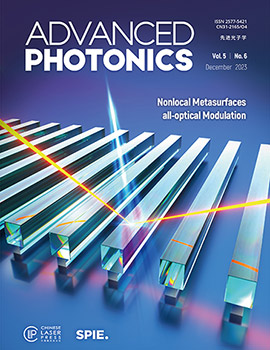Unconventional bound states in the continuum from metamaterial-induced electron acoustic waves
IF 18.8
1区 物理与天体物理
Q1 OPTICS
引用次数: 0
Abstract
. Photonic bound states in the continuum (BICs) are spatially localized modes with infinitely long lifetimes, which exist within a radiation continuum at discrete energy levels. These states have been explored in various systems, including photonic and phononic crystal slabs, metasurfaces, waveguides, and integrated circuits. Robustness and availability of the BICs are important aspects for fully taming the BICs toward practical applications. Here, we propose a generic mechanism to realize BICs that exist by first principles free of fine parameter tuning based on non-Maxwellian double-net metamaterials (DNMs). An ideal warm hydrodynamic double plasma (HDP) fluid model provides a homogenized description of DNMs and explains the robustness of the BICs found herein. In the HDP model, these are standing wave formations made of electron acoustic waves (EAWs), which are pure charge oscillations with vanishing electromagnetic fields. EAW BICs have various advantages, such as (i) frequency-comb-like collection of BICs free from normal resonances; (ii) robustness to symmetry-breaking perturbations and formation of quasi-BICs with an ultrahigh Q -factor even if subject to disorder; and (iii) giving rise to subwavelength microcavity resonators hosting quasi-BIC modes with an ultrahigh Q -factor.超材料诱导的电子声波连续体中的非常规束缚态
. 连续介质中的光子束缚态是存在于辐射连续介质中离散能级上的具有无限长寿命的空间局域模式。这些状态已经在各种系统中进行了探索,包括光子和声子晶体板、超表面、波导和集成电路。bic的健壮性和可用性是使bic完全适应实际应用的重要方面。在此,我们提出了一种基于非麦克斯韦双网超材料(dnm)的通用机制来实现不需要精细参数调整的第一性原理存在的BICs。理想的热流体动力学双等离子体(HDP)流体模型提供了dnm的均匀描述,并解释了本文发现的bic的鲁棒性。在HDP模型中,这些是由电子声波(EAWs)构成的驻波,它们是电磁场消失的纯电荷振荡。EAW bic具有各种优点,例如(i)没有正常共振的频率梳状bic集合;(ii)对对称破缺扰动的鲁棒性和超高Q因子的准bic的形成,即使受到无序影响;(iii)产生具有超高Q因子的准bic模式的亚波长微腔谐振器。
本文章由计算机程序翻译,如有差异,请以英文原文为准。
求助全文
约1分钟内获得全文
求助全文
来源期刊

Advanced Photonics
OPTICS-
CiteScore
22.70
自引率
1.20%
发文量
49
审稿时长
18 weeks
期刊介绍:
Advanced Photonics is a highly selective, open-access, international journal that publishes innovative research in all areas of optics and photonics, including fundamental and applied research. The journal publishes top-quality original papers, letters, and review articles, reflecting significant advances and breakthroughs in theoretical and experimental research and novel applications with considerable potential.
The journal seeks high-quality, high-impact articles across the entire spectrum of optics, photonics, and related fields with specific emphasis on the following acceptance criteria:
-New concepts in terms of fundamental research with great impact and significance
-State-of-the-art technologies in terms of novel methods for important applications
-Reviews of recent major advances and discoveries and state-of-the-art benchmarking.
The journal also publishes news and commentaries highlighting scientific and technological discoveries, breakthroughs, and achievements in optics, photonics, and related fields.
 求助内容:
求助内容: 应助结果提醒方式:
应助结果提醒方式:


